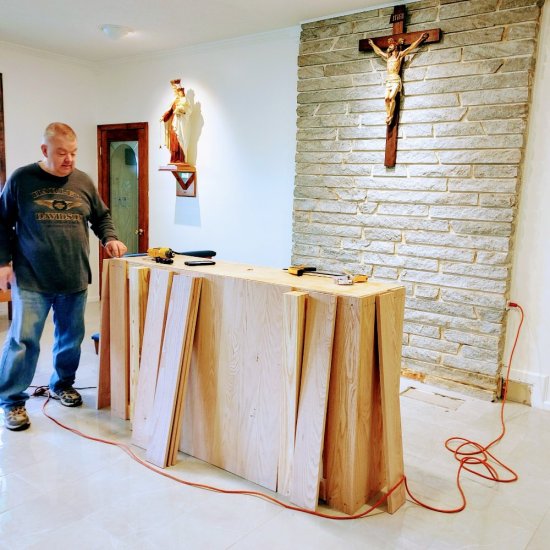Download the PDF extracted from Carlo Rossini’s Proper of the Mass (1933).
(We agree on everything but the pronunciation of mihi and nihil, that should be prononunced regularly by keeping the h mute. ‘Miki‘ and ‘nikil‘ are not acceptable anymore)
Auxilia ad Missam in forma ordinaria celebrandam secundum Œcumenicum Concilium Vaticanum II
Download the PDF extracted from Carlo Rossini’s Proper of the Mass (1933).
(We agree on everything but the pronunciation of mihi and nihil, that should be prononunced regularly by keeping the h mute. ‘Miki‘ and ‘nikil‘ are not acceptable anymore)
V/. Bénedic, Dómine, nos et hæc tua dona quæ de tua largitáte sumus sumptúri. Per Christum Dóminum nostrum.
R/. Amen.
Ante prandium
V/. Mensæ cæléstis partícipes faciat nos, Rex ætérnæ glóriæ.
R/. Amen.
Ante cenam
V/. Ad cenam vitæ ætérnæ perducat nos, Rex ætérnæ gloriæ.
R/. Amen.
Post prandium vel cenam
V/. Ágimus tibi gratias, omnípotens Deus, pro univérsis benefíciis tuis, qui vivis et regnas in sǽcula sæculórum.
R/. Amen.
V/. Deus det nobis suam pacem.
R/. Et vitam ætérnam.
R/. Amen.
(Parish of Holy Redeemer in Andrews and Prince of Peace in Robbinsville)

“The rule in the diocese here is that any sanctuary renovation must situate the altar to that the priest might be able to offer Holy Mass versus populum and also possibly ad orientem. Only with the most extreme difficulty could Holy Mass be offered ad orientem with the previous situation of a necessarily altogether too small platform raising the altar above the rest of the sanctuary floor.
What we were looking for is a real altar. Accomplishing that provided the opportunity to remove the platform. Doing that meant that the altar could now boast of possibilities for both the “ordinary” and the “extraordinary” Roman Rite(s) of the Holy Sacrifice.
We’re preparing for the sake of charity and reverence altar rails or more accurately Communion rails. We’re in discussion stages for the construction and security of the logistics for the Tabernacle. The lectern, the credence table, what we call the Mary table are also in the works. This is being done with donations, not from the parish funds.
You’ll notice that the altar beginnings pictured above with one of our parishioners seems to lack depth, and even length. But you’ll have to use your imagination coupled with a knowledge of how this altar is going to be used, possibly from both sides. When the granite altar top, the mensa is installed, it will over overhang a few inches both sides lengthwise and about six inches depthwise both in front and back. And, not to worry, we’re making sure this will not be tippy as was the other altar. The previous altar could literally be pushed over with one finger, and that’s been that way for some 55 +- years.
We’re aiming for high quality. The porcelain floor is from India, the granite from Brazil (that being in mockery of Pachamama).
We want the best for our dear Lord, next to whose Sacrifice His good mom stands.”
Source: here.
Mons. Andrea Caniato, canonico della Cattedrale di Bologna, sta compilando il repertorio gregoriano delle antifone della Liturgia delle Ore, secondo l’Ordo Cantus Offici (II edizione).
Si tratta di una versione completa per il canto della Liturgia delle Ore (lasciando il canto dei Salmi in lingua vernacola).
Non sempre c’è corrispondenza tra i testi della Liturgia Horarum e le antifone previste per il canto, ma si tratta comunque di variazioni stabilite e approvate, contenute in un testo liturgico ufficiale.
Mons. Caniato generosamente condivide ora con noi la parte relativa al Tempo di Pasqua. In futuro ci manderà gli altri periodi liturgici.
Tra l’altro, è possibile notare che l’antifonario della Liturgia delle Ore contiene molto materiale che può essere utilizzato anche per la s. Messa, in analogia a quanto proposto dal Graduale Simplex.
Le antifone sono infatti molto più accessibili rispetto ai canti del Graduale.
Ringraziamo mons. Caniato per l’impegno e la generosità!
Potete scaricare l’Antifonario del Tempo di Pasqua qui.
Bollettino informativo del centro di Canto Gregoriano e monodie «Dom Jean Claire» – Verona n° 1 – Gennaio – Aprile 2021:
Per info: gregorianavox@gmail.com